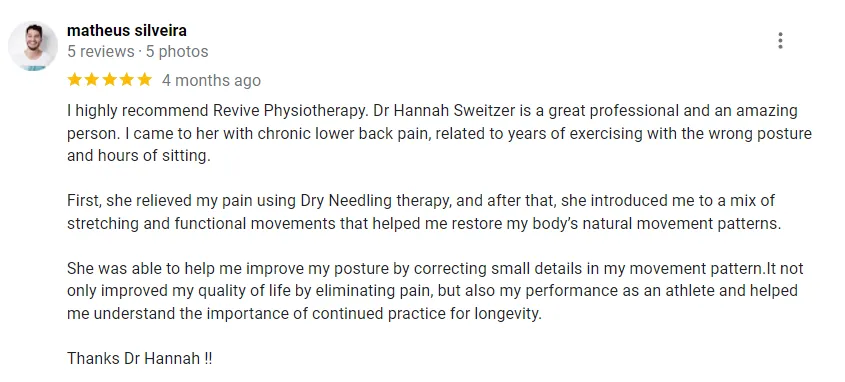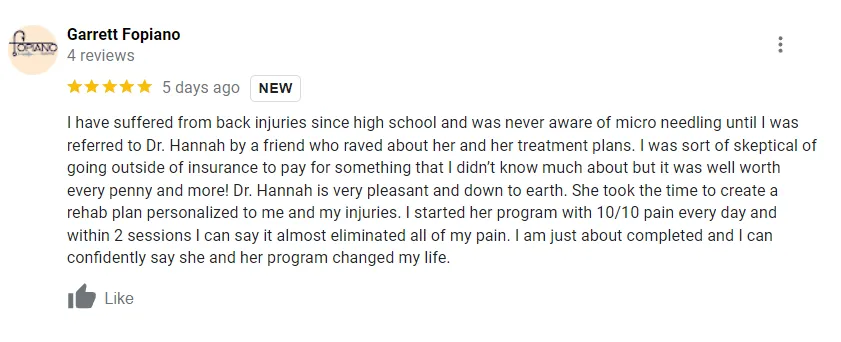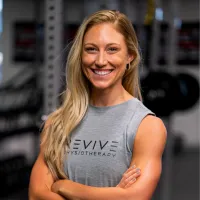Resources
For When You Need Help NOW
YOUTUBE VIDEOS
Enjoy a wide range of YouTube videos below to find relief fast!
Yoga For
Back Pain
Help! I Just Threw
Out My Back!
Yoga
For Runners
Neck and Back Pain Relief (Part 1)
Why Your Hip Might Be Causing Your Knee/Ankle/Foot Pain
Dr. Hannah’s Top 4 Glute Activation Exercises to Reduce Back Pain
Dr. Hannah’s Top 4
Strength Exercises
for Runners
Dr. Hannah’s Top 4
Miniband Exercises
for Runners
READ OUR BLOG

Tendon Training vs. Muscle Training
Tendon Training vs. Muscle Training: Why They’re Not the Same
Introduction
At Revive Physiotherapy, we help people develop strength that endures, which includes not just larger muscles, but also stronger tendons, healthy joints, and more resilient movement patterns. An important principle we teach is that muscle training and tendon training are not the same thing.
Muscles and tendons may work together, but they develop differently and require different types of exercise to thrive. Everyone is familiar with training muscles, but tendons? That’s where things get tricky.
In this post, we’ll cover:
The anatomical and biomechanical contrasts between tendons and muscles.
Why tendons require both heavy slow resistance training and plyometric exercises.
Practical tendon training strategies to maintain strong muscles and elastic, springy, injury-resistant tendons.
Muscle vs Tendon: Designed for Different Jobs
Muscles: The Force Producers
Muscles are fibers that shorten to create movement. They are:
Highly vascular → heal and adapt quickly.
Dynamic and versatile → grow in size and strength when challenged.
Neural powerhouses → train to recruit more fibers efficiently.
Role of muscles: create force.
Tendons: The Springs and Shock Absorbers
Tendons are dense, rope-like collagen strands that connect muscle to bone. They are:
Poorly vascularized → healing and adaptation are much slower.
Stiff yet elastic → made to store and release energy like a spring.
Non-contractile → remodel collagen and adjust stiffness, not size.
Functions of tendons: transmit force, stabilize joints, provide elastic recoil.
How Tendons Are Special: Elastic Recoil
Tendons, unlike muscles, act like biological springs. They store and release energy, making movement both powerful and efficient.
Examples:
Achilles tendon during sprinting → stretches under body weight, recoils, and propels you forward.
Patellar tendon during jumping → stores energy on the squat-down, releases explosively as you jump.
👉 Without proper tendon training, you lose this spring-like efficiency, resulting in slower performance, increased energy cost, and higher injury risk.
How Muscles and Tendons Adapt Differently
Muscles Adapt Fast
Grow (hypertrophy) in weeks.
Respond to multiple rep ranges and loads.
Improve with both heavy strength training and light endurance work.
Tendons Adapt Slowly
Remodel over 8–12+ weeks.
Require high loads at slow speeds for collagen alignment.
Need plyometric training to remain elastic and efficient.
👉This means muscles get stronger fast while tendons adapt slowly—but tendons must stay both strong and springy.
Muscles vs. Tendons: Training Principles
Training Muscles
Methods: Hypertrophy (8–12 reps), strength (3–6 reps), endurance (12–30 reps), power (explosive lifts).
Adaptation speed: Weeks to months.
Goal: Bigger, stronger, and more coordinated muscles.
Training Tendons
Heavy Slow Resistance (HSR): 3–4 sets of 6–8 reps at 70–85% max, 3–4 sec up/down, 2–3x/week → builds stiffness and load tolerance.
Isometrics: 30–45 seconds heavy static holds → reduce pain, prime tendon stiffness.
Eccentrics: Controlled lengthening (heel drops for Achilles, etc.).
Plyometrics (important for elasticity): jumping, bounding, pogo hops, skipping drills → restore recoil and efficiency.
Adaptation speed: 8–12+ weeks for stiffness; lifelong plyometric benefits with consistent training.
Goal: Strong tendons that can handle load, stay elastic, and reduce injury risk.
The Importance of Plyometric Training for Tendons
Heavy, slow work builds tendon stiffness, but stiffness without elasticity is useless. Plyometrics bridge the gap between tendon health and performance.
Benefits of plyometric tendon training:
Restores elastic recoil → efficient running and jumping.
Enhances shock absorption → protects joints.
Improves energy storage capacity → tendons act like springs again.
Boosts coordination and reflex speed → faster load/unload cycles.
👉 Athletes without plyometrics risk being “strong but slow.”
Rehab Case Example 1: Achilles Tendinopathy
Phase 1: Isometrics → heavy mid-range calf raises, 30–45 sec.
Phase 2: Heavy Slow Loading → standing calf raises, 6–8 reps, 3–4 sec tempo.
Phase 3: Plyometrics → pogo jumps, skipping, bounding.
Phase 4: Return to sport drills → sprints, cutting, sport-specific plyos.
👉 Skipping the last phase means the tendon never regains springiness, leaving reinjury risk high.
Rehab Case Example 2: Patellar Tendon (Jumper’s Knee)
Phase 1: Isometric wall sits or leg press holds.
Phase 2: Heavy slow decline squats.
Phase 3: Plyometrics → depth jumps, single-leg hops, box jumps.
👉 This restores the stretch-shortening cycle needed for powerful jumping and safe landings.
Putting It All Together: Training Both Systems
For Muscles:
Train 2–4x/week.
Mix rep ranges (strength, hypertrophy, endurance).
Expect fast results in weeks.
For Tendons:
Train 2–3x/week with longer recovery.
Combine heavy slow loading with plyometrics.
Expect real changes after 8–12+ weeks.
Takeaway
They might collaborate, but muscles and tendons do not work the same way:
Muscles are fast-adapting force generators.
Tendons are slow-adapting springs requiring both strength and elasticity.
At Revive Physiotherapy, we help our patients not just get stronger, but become more resilient, durable, and springy! Because true performance isn’t just about lifting heavier, it’s about building a body that’s efficient, injury-resistant, and built to last.
👉 If you’ve experienced tendon pain or want to train for injury prevention and performance, our team can develop a customized plan to strengthen both muscles and tendons.
📞 Call today or 💻 book online to begin building strength, elasticity, and resilience that lasts.
Our one-on-one treatment sessions ensure that you fully understand your body and take ownership of your health so that you can have control over doing the things you love!
Send us a Message
Let's Have a Chat
954 - 519 - 4185
Find us at
2852 E Oakland Park Blvd
Fort Lauderdale, FL 33306
2024 REVIVE PHYSIOTHERAPY | ALL RIGHTS RESERVED






